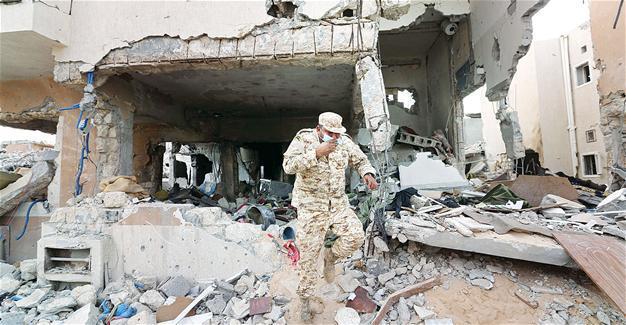Disease and mines rule in Libya’s former ISIL bastion
SIRTE, Libya

In the district of Al-Giza al-Bahriya in Libya’s Sirte, the sea breeze mingles with the stench of corpses decomposing under the rubble.
The coastal neighborhood was the last part of the Islamic State of Iraq and the Levant’s (ISIL) north African bastion to fall to unity government-allied forces on Dec. 5 after nearly seven months of fighting.
Two weeks later, many residents of Sirte are unable to return to their homes - those that are still standing.
“We fear an epidemic,” said Ahmad Bala, a commander of pro-government forces, who sat in a 4x4 and wore a mask to block the stink.
“The situation in Al-Giza al-Bahriya doesn’t allow residents to go home. Dozens of corpses are still under the rubble. The smell is horrible and there is a risk of catching diseases,” he said.
Forces allied with Libya’s Government of National Accord were supported by the United States, which hammered the district with air strikes until it announced an end to its Sirte operations on Dec. 20.
Bala said ISIL jihadists and their families hid in tunnels to escape the bombing.
“They were found trapped. Men, but also women and children who died of hunger and thirst under the rubble,” he said.
“We don’t have the capacity to extract the bodies or demine the area, which was stuffed with explosive devices” by ISIL, he said.
In Al-Giza al-Bahriya’s central square, three corpses lie in black bags on the ground, largely ignored by passers-by.
“The [Libyan] Red Crescent pulled them out of the rubble two days ago. They put them here and left,” said Mohammed, another pro-government fighter.
“We shouldn’t blame them. They have no resources.”
At a roundabout a few hundred meters away, barely a building is left standing. The area has become a wasteland of concrete and scrap metal.
Containers block the main arteries of residential areas along the sea front, the most affected by the fighting, “to prevent onlookers from approaching,” Bala said.
The town still lacks mobile phone and internet connections within a 100-kilometer (60-mile) radius.
 In the district of Al-Giza al-Bahriya in Libya’s Sirte, the sea breeze mingles with the stench of corpses decomposing under the rubble.
In the district of Al-Giza al-Bahriya in Libya’s Sirte, the sea breeze mingles with the stench of corpses decomposing under the rubble.